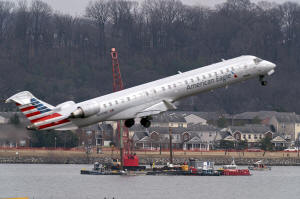Hotline between military and air traffic controllers in Washington
hasn't worked for over 3 years
[May 15, 2025]
By JOSH FUNK
A hotline between military and civilian air traffic controllers in
Washington, D.C., that hasn't worked for more than three years may have
contributed to another near miss shortly after the U.S. Army resumed
flying helicopters in the area for the first time since January's deadly
midair collision between a passenger jet and a Black Hawk helicopter,
Sen. Ted Cruz said at a hearing Wednesday.
The Federal Aviation Administration official in charge of air traffic
controllers, Frank McIntosh, confirmed the agency didn't even know the
hotline hadn't been working since March 2022 until after the latest near
miss. He said civilian controllers still have other means of
communicating with their military counterparts through landlines. Still,
the FAA insists the hotline be fixed before helicopter flights resume
around Ronald Reagan Washington National Airport.
The Army said in a statement Wednesday that is it “working with the FAA
to resolve the direct communications line between the Pentagon pad tower
and the DCA tower and determine what repairs are required to restore
services.” DCA is the code for Reagan airport.
It said the Army “continues to restrict flights to the Pentagon pad to
only mission essential operations until the line is repaired or improved
communication procedures are implemented and accepted by the FAA.”
The FAA said in a statement that the dedicated direct access line
between air traffic controllers at Reagan and the Pentagon's Army
heliport hasn't worked since 2022 because of the construction of a new
tower at the Pentagon. But the FAA said “the two facilities continue to
communicate via telephone for coordination.”
“The developments at DCA in its airspace are extremely concerning,” Cruz
said. “This committee remains laser-focused on monitoring a safe return
to operations at DCA and making sure all users in the airspace are
operating responsibly.”

The Army suspended all helicopter flights around Reagan airport after
the latest near miss, but McIntosh said the FAA was close to ordering
the Army to stop flying because of the safety concerns before it did so
voluntarily.
“We did have discussions if that was an option that we wanted to
pursue,” McIntosh told the Senate Commerce Committee at the hearing.
Jeff Guzzetti, a former NTSB and FAA accident investigator, said “the
fact that they were unaware that this connection was not working for
three years is troublesome.” But he is not entirely clear on the purpose
of the hotline when controllers had other ways to communicate.
But Guzzetti thinks the Army needs to be more forthcoming about what it
is doing to ensure the airspace around Washington remains safe. Since
the crash, the Army has at times refused to provide information that
Congress has asked for, and officials didn't answer all the questions at
a previous hearing.
[to top of second column]
|

Salvage crews work on recovering wreckage near the site in the
Potomac River of a mid-air collision between an American Airlines
jet and a Black Hawk helicopter at Ronald Reagan Washington National
Airport, Thursday, Feb. 6, 2025, in Arlington, Va. (AP Photo/Jose
Luis Magana, File)

“The DCA airspace is under the white hot spotlight. So the Army’s
going to have to be more transparent and more assertive in their
dealings with this problem,” Guzzetti said.
According to a U.S. official, one course of action under
consideration now is to have the Army give 24 hours notice of any
flights around National Airport. The official spoke on condition of
anonymity because no decisions have been made and discussions are
ongoing.
January's crash between an American Airlines jet and an Army
helicopter killed 67 people — making it the deadliest plane crash on
U.S. soil since 2001. The National Transportation Safety Board has
said there were an alarming 85 near misses around Reagan in the
three years before the crash that should have prompted action.
Since the crash, the FAA has tried to ensure that military
helicopters never share the same airspace as planes, but controllers
had to order two planes to abort their landings on May 1 because of
an Army helicopter circling near the Pentagon.
“After the deadly crash near Reagan National Airport, FAA closed the
helicopter route involved, but a lack of coordination between FAA
and the Department of Defense has continued to put the flying public
at risk,” Sen. Tammy Duckworth said.
McIntosh said the helicopter should never have entered the airspace
around Reagan airport without permission from an air traffic
controller.
“That did not occur,” he said. “My question — and I think the larger
question is — is why did that not occur? Without compliance to our
procedures and our policies, this is where safety drift starts to
happen.”
The NTSB is investigating what happened.
In addition to that incident, a commercial flight taking off from
Reagan airport had to take evasive action after coming within a few
hundred feet of four military jets heading to a flyover at Arlington
National Cemetery. McIntosh blamed that incident on a
miscommunication between FAA air traffic controllers at a regional
facility and the tower at Reagan, which he said had been addressed.
___
Associated Press writer Lolita C. Baldor contributed to this report.
All contents © copyright 2025 Associated Press. All rights reserved |